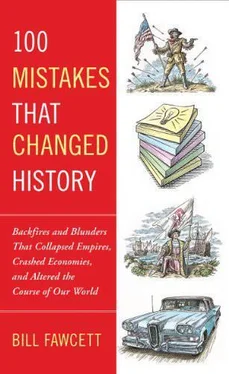Saladin then ordered his horsemen to attack the hills. One attack was beaten back, then another, and another. But the waterless defenders lost more men with each charge. By the end, only a few hundred knights remained able to fight when yet another charge overwhelmed them at the top of the hill. Many of the fallen Christians were found to be only lightly wounded and many had passed out from dehydration and heat stroke. Most of these were revived and spent the rest of their lives as slaves building stone walls around Cairo, Egypt. In the weeks that followed, with too few defenders, most of Outremer’s castles and cities had no choice but to surrender when Saladin approached.
Guy of Lusignan had fought the war in the way that he needed, but he risked losing all the kingdom to Saladin. And lose it he did. It was almost 200 years before the last Outremer holdings on Cyprus were captured, but after Guy put his army in a position that played to the enemy’s strengths, the end was inevitable. The original goal of so many crusades, Jerusalem, was lost forever, and the history of the Middle East became a tale of only Islam.
Constantinople and Bust: The Fourth Crusade
1204
Venice in the late twelfth century was a unique place. Although it had originally been a Byzantium port, it grew to be a world power through commerce and trade. In a time when feudalism was at its peak, this mercantile city ran much more like a modern business than a medieval city. Rather than being ruled over by a king, Venice had a ruling council of nine men, who behaved more like a board of directors than royal advisers. At the head of the council sat the CEO, the doge. Most of us have heard the title of Venice’s elected ruler, but few grasp the importance the doges played in the history of the Western world. One doge in particular, Enrico Dandolo, instigated an act that had resounding repercussions throughout the medieval world as well as our world today—the sacking of Constantinople.
What did the doge have against Constantinople? Quite a bit as it turns out. In addition to holding a monopoly on the markets in Germany and northern Italy, the Venetians also set up trade with eastern Europe and the Muslim world. They traded for silk and spices. In exchange, they manufactured ships and became the world’s leading exporter of glass and ironworks. Their focus on a maritime economy ensured Venice’s rise in status over Genoa and Pisa. The Achilles’ heel in their great enterprise was the Byzantine empire. To trade with the East, merchants in Venice had to pass through Constantinople. In 1183, Andronicus Comnenus seized power as emperor in Byzantium and revoked all permits for Venetian merchants. This put Venice’s status as the leader in world trade in jeopardy. Just when the city started to feel the pinch of economic pressure due to its limited commerce, an opportunity presented itself.
In 1201, Pope Innocent asked for the doge’s help in transporting men and supplies for another expedition to the Holy Land. He intended to send his crusading armies into Alexandria in Egypt. The pope wanted to avoid asking for too much help from the European princes because it might call into question his authority. And, he did not wish to upset the Holy Roman empire. The doge was more than willing to help with the expedition… for a price. After all, business is business. He asked for half of everything captured in the expedition, and he wanted money up front. In exchange, he would provide transport and fifty Venetian galleys to escort the crusaders on their venture. The following year, 11,000 crusaders made their way to Venice under the leadership of Boniface de Montferrat. However, Montferrat put the expedition on hold because the crusaders could not pay the huge sum the doge asked for. The doge was first and last a businessman. He knew that having 11,000 men camped within the city would not be good for business. So, he offered an alternative.
Hungary had recently captured the Venetian city of Zara off the Adriatic coast. Lacking the military strength to recapture it, the doge saw the chance to use the crusaders for his own interests. He offered to postpone the initial payment in exchange for the crusader’s help in taking back Zara. Many of the crusaders were outraged at the concept of fighting their fellow Christians, and the king of Hungary had fought in previous expeditions to the Holy Land. The doge took up the Cross, not because of a strong religious conviction, but because he saw a chance to manipulate the crusaders into thinking he was a man for their cause. In the end, they relented. Thousands of Venetians also joined the expedition. This was not a holy expedition led by the pope. It was a business venture led by the doge of Venice.
In October 1202, 200 Venetian ships made way for Zara. They arrived in November and laid siege to the city. After only two weeks, the people of Zara surrendered. This was not the expedition that Rome had in mind—Christian fighting against Christian. The pope excommunicated all involved. The crusaders did not wish to lose their souls in an endeavor to appease the doge, so they petitioned Rome, saying that they had no choice in the matter. The pope lifted the excommunication for all except Doge Dandolo and his men.
Meanwhile, a situation arose in Constantinople that would work in favor of the doge. The emperor, Isaac, had been blinded and imprisoned by his brother, Alexius, who took the throne as Alexius III. Isaac’s son, also called Alexius, went to Zara to solicit help from the Venetian and crusader forces. What he offered in return was too irresistible to refuse. The Byzantine Church would be placed under the authority in Rome, huge financial incentives were offered to all who helped, and 10,000 soldiers would accompany the crusaders to Alexandria in Egypt, which was the original destination, after all. The doge could not have been happier.
The Venetian and crusader forces arrived off the coast of Constantinople on June 24, 1203. They soon captured the suburb of Galata, which lies just north of the city across the Bosphorus. Then they launched a simultaneous land and sea attack on Constantinople, which failed. Despite the failure, Alexius III became frightened and fled the city. Advocates for Isaac freed him and returned him to the throne. Isaac and his son ruled together. They recognized immediately that they had a serious problem. They would have to abide by the terms agreed to in the treaty. Alexius went throughout the city raising funds to pay the crusaders. In the meantime, anticrusader sentiment raged throughout the city. The citizens revolted. Isaac and Alexius were killed and the anti-Western figurehead Ducus Murzuphlus took over as Alexius V. He immediately made it clear that he had no intention of paying the crusading forces anything.
Doge Dandolo took full advantage of the situation to persuade the crusaders to attack the city. On April 12, 1204, the Venetians penetrated the walls of the city. What they and the crusaders did to their fellow Christians was unconscionable. They looted homes and churches, murdered and raped the citizens, and held a thanksgiving service after all was said and done. The clerics who were involved in the expedition justified the action by saying it was done to reunite the Church. Although Pope Innocent did not authorize the action, he did not condemn it either. No doubt he saw the act as beneficial to the Western Church.
The act would not be beneficial to the Church in the long run. The Byzantine empire disintegrated and was replaced by small, autonomous Greek and Latin provinces. Without the strong presence of the Byzantines, the Turks were able to easily take Constantinople, giving them a gateway into Europe.
Читать дальше












